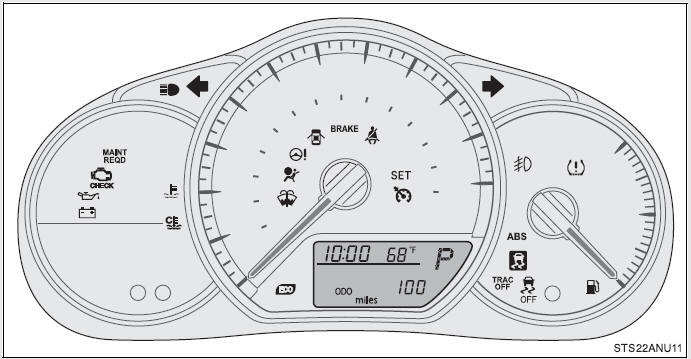 Toyota Yaris: Indicators and warning lights
Toyota Yaris: Indicators and warning lights
The indicators and warning lights on the instrument cluster, center panel and dashboard inform the driver of the status of the vehicle’s various systems.
Instrument cluster (vehicles without a tachometer)

Instrument cluster (vehicles with a tachometer)

Center panel

Dashboard

■ Indicators
The indicators inform the driver of the operating state of the vehicle’s various systems.

Turn signal indicator (→P. 130)

Headlight high beam indicator (→P. 146)

(if equipped)
Front fog light indicator (→P. 148)

Low engine coolant temperature indicator Indicates the engine coolant temperature is cool.

(if equipped)
Engine immobilizer/ alarm system indicator (→P. 72, 74)

(vehicles with an automatic transmission)
Eco Driving Indicator Light (→P. 115)

(vehicles with an automatic transmission)
Shift position and shift range indicator (→P. 127)

(if equipped)
Cruise control indicator (→P. 158)

(if equipped)
Cruise control “SET” indicator (→P. 158)

*1,2
Slip indicator (→P. 163)

*1
VSC OFF indicator (→P. 164)

*1
“TRAC OFF” indicator (→P. 163)

*1
“AIR BAG ON” indicator (→P. 92)

*1
“AIR BAG OFF” indicator (→P. 92)
*1: These lights turn on when the engine switch is turned to the “ON” position to indicate that a system check is being performed. They will turn off after the engine is started, or after a few seconds. There may be a malfunction in a system if a light does not come on, or if the lights do not turn off. Have the vehicle inspected by your Toyota dealer.
*2: The light flashes to indicate that the system is operating.
■ Warning lights
Warning lights inform the driver of malfunctions in any of the vehicle’s systems. (→P. 305)
*1

(except Canada)
*1

(Canada)
*1

*1

*1

*1

(except Canada)
*1

(Canada)
*1

*1

(except Canada)
*1

(Canada)
*1

*1,2

*3

(if equipped)



*1

(except Canada)

(if equipped)
*1

(except Canada)
*1: These lights turn on when the engine switch is turned to the “ON” position to indicate that a system check is being performed. They will turn off after the engine is started, or after a few seconds. There may be a malfunction in a system if a light does not come on, or if the lights do not turn off. Have the vehicle inspected by your Toyota dealer.
*2: The light flashes to indicate that the system is operating and come on to indicate a malfunction.
*3: The light flashes to indicate a malfunction.
CAUTION
■If a safety system warning light does not come on
Should a safety system light such as the ABS and SRS warning light not come on when you start the engine, this could mean that these systems are not available to help protect you in an accident, which could result in death or serious injury. Have the vehicle inspected by your Toyota dealer immediately if this occurs.
 Gauges and meters
Gauges and meters
Vehicles without a tachometer
Speedometer'
Displays the vehicle speed
Outside temperature display
→P. 211
Fuel gauge
Displays the quantity of fuel remaining in the tank
Display ...
 Multi-information display
Multi-information display
The multi-information display presents the driver with a variety of driving-related
data.
● Odometer (→P. 141)
● Trip meter (→P. 141)
● Trip information (→P. ...
See also:
Rear floor pan extension (ASSY): Sedan
REPLACEMENT
With the body lower back panel removed.
REMOVAL
INSTALLATION
Temporarily install the new parts and measure each part of the new parts in accordance
with the body dimension diagra ...
Alarm (Puerto Rico)
The system sounds the alarm and flashes the lights when forced entry is detected.
■ Triggering of the alarm
The alarm is triggered in the following situations when the alarm is set:
● A ...
Abbreviations used in this manual
For convenience, the following abbreviations are used in this manual.
ABS Antilock Brake System.
A/C Air Conditioner.
assy assembly.
ECT Electronic Controlled Transmission.
ECU Electronic Control ...
